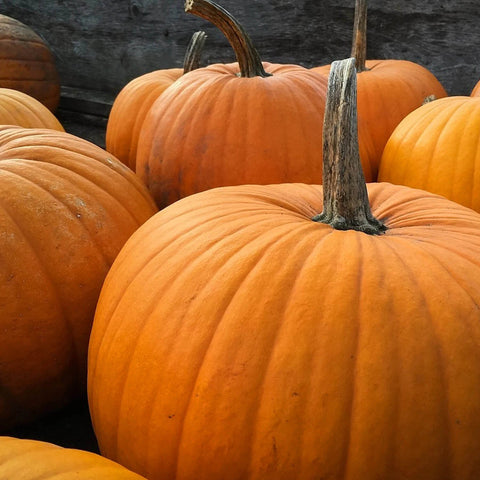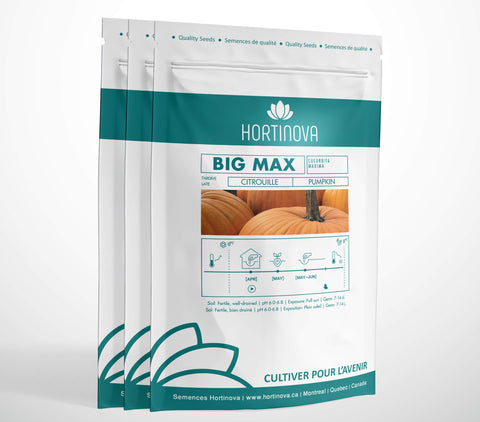

Hortinova
BIG MAX - Open Pollinated Pumpkin Seeds
Cucurbita maxima
- Late maturity.
- Very large exhibition sized fruit.
- Perfect for carving into Jack ‘o Lanterns.
- Thick, red-orange skin with bright yellow flesh.
- Open-pollinated seeds.
- Natural, Untreated, Non-GMO Seeds.
Start seeds indoor after the last spring frost using cell trays. Loosely pack some potting soil in a cell tray. Plant two to four pumpkin seeds 1 inch (2.5 cm.) deep in the soil. Water the pumpkin seeds just enough so that the soil is moist but not swamped. Place the cup on a heating pad. Once seeds have germinated, thin out all but the strongest seedling, then place the seedlings under a light source such us a bright window. Keeping the seedling on the heating pad will cause it to grow faster.
Pumpkins are sensitive to the cold. Do not sow seeds directly until well after danger of frost is past and the soil is between 65° and 95°F (18° to 35°C). If the soil is at 70°, seedlings should emerge in 5 to 10 days. For cooler climates, this is often in late May. Sow seeds 2cm (1″) deep in hills spaced 6 feet apart. Sow 3 seeds in each spot you want a plant to grow and thin to the strongest plant.
PLANT OUT: If sowing indoors, harden off seedlings before transplanting into warm, aged manure/compost-enriched soil. Try to get the plants into the ground no later than the summer solstice. Space plants at a minimum of 90-120cm (3-4 feet) apart in rows 120-180cm (4-6 feet) apart.
EXPOSURE: Pick a spot in full sun with space for sprawling vines to run: 50 to 10 square feet per plant. If space is limited, plant at the edge of the garden and direct vine growth across the lawn or paths.
WATER: Pumpkins need 1 inch of water per week. Water deeply, in the morning and on very hot afternoons, especially during fruit set. Avoid watering foliage and fruit unless it’s a sunny day. Dampness invites rot and disease.
FEED: Pumpkins are heavy feeders. It’s important to mix aged manure and/or compost into the soil. Side-dress with aged manure or compost mixed with water. When plants are about 1 foot tall, just before vines begin to run, fertilize regularly with a high-nitrogen formula. Just before the blooming period, switch to a high-phosphorus formula fertilizer.
PROTECT: Use row covers to protect plants early in the season and to prevent insect problems. However, remember to remove covers before flowering to allow pollination. Add mulch around your pumpkins to retain moisture, suppress weeds, and discourage pests. Weed gently; pumpkins have shallow roots that can be easily damaged. Also, take care not to damage the delicate vines; the quality of the fruit depends on them.
Harvest pumpkins when they are fully mature—and not before. They will keep best this way. Do not pick pumpkins off the vine because they have reached your desired size. (For smaller pumpkins, grow a small variety). Harvest on a dry day after the plants have died back and the skins are hard. The skin of a ripening pumpkin turns a deep, solid color (orange for most varieties) and the stem hardens. Thump the pumpkin with a finger; the rind will feel hard and sound hollow. Press a fingernail into the pumpkin’s skin; if it resists puncture, it is ripe. Carefully cut the fruit off the vine with a sharp knife or pruners; do not tear it. Be sure not to cut too close to the pumpkin. Leave 3 to 4 inches of stem to increase its keeping time. Handle pumpkins very gently or they may bruise. Never carry a pumpkin by its stem.
Let customers speak for us
from 2 reviewsTRISTAN F1 - Hybrid Summer Squash Seeds

KOSAK - Open Pollinated Red Beet Seeds












